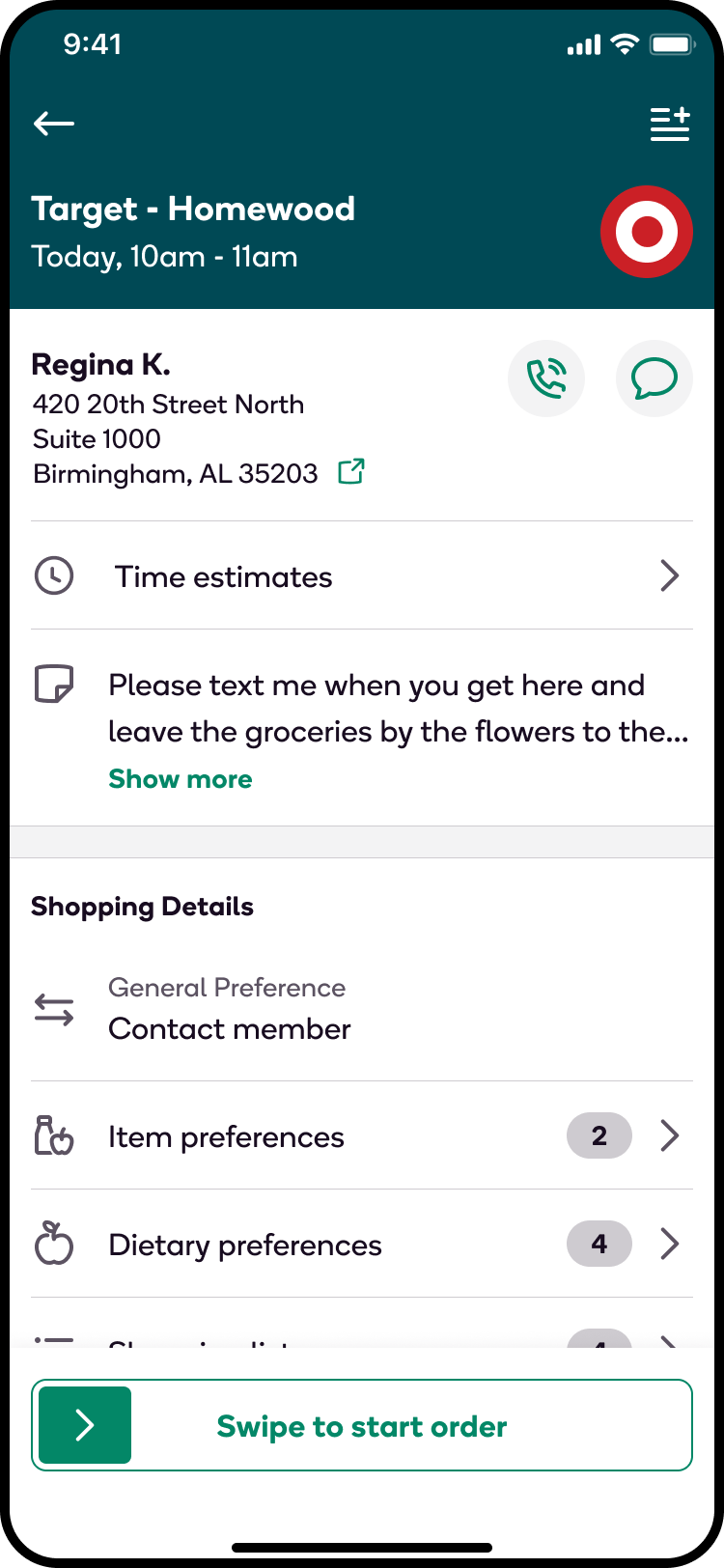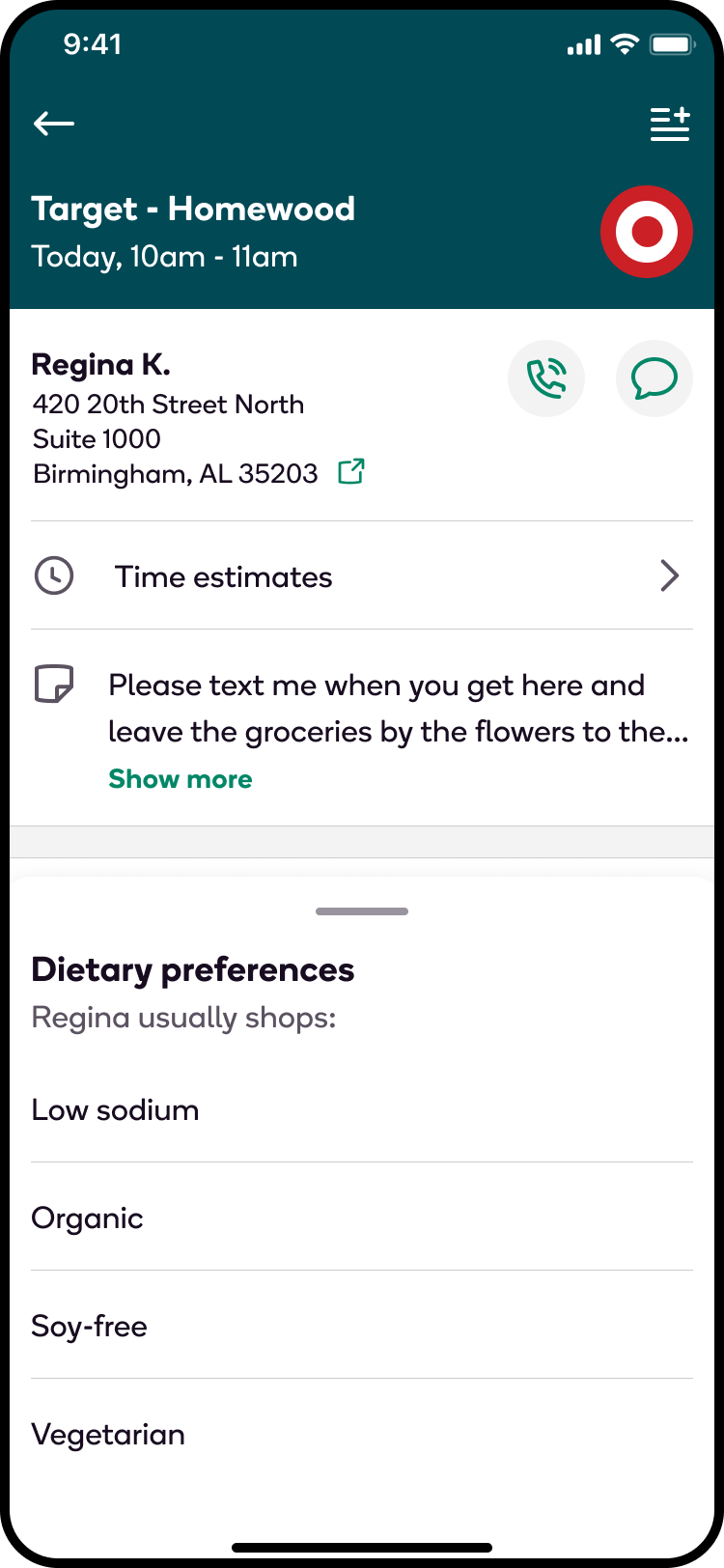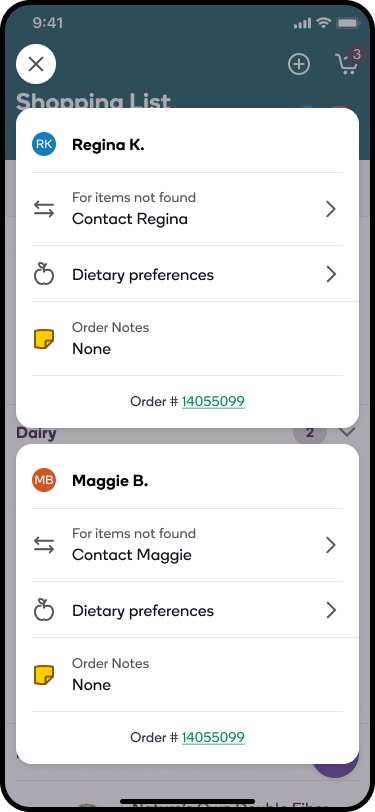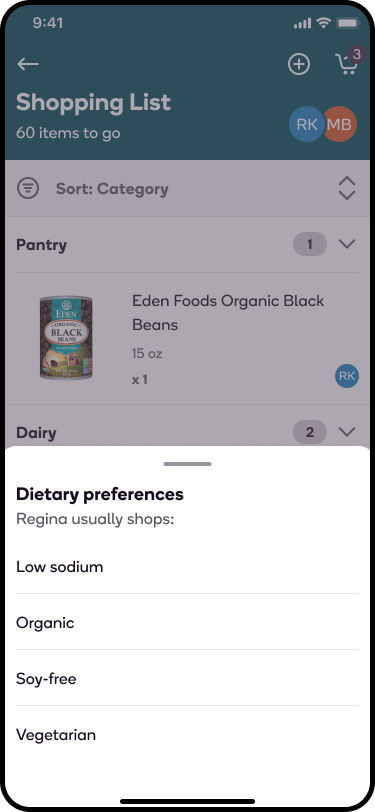Los miembros tienen la posibilidad de establecer preferencias dietéticas para su cuenta, lo que les permite obtener recomendaciones de alimentos que puedan preferir al realizar un pedido.
Si un miembro ha establecido sus preferencias dietéticas para su cuenta, podrá revisarlas después de reclamar su pedido. Mientras compra, también verá preferencias específicas enumeradas debajo de los artículos que coinciden con los artículos cuando busque un artículo para agregar o sustituir. La aplicación recomendará artículos según las preferencias del miembro, donde los artículos preferidos se mostrarán en la parte superior de la lista de artículos recomendados para ayudarlo a encontrar fácilmente los artículos que a los miembros les encantarán primero. Esto le brinda una oportunidad más de entablar una conexión con los miembros.
- Para revisar la lista de preferencias alimentarias de un miembro, presione Dietary preferences (Preferencias alimentarias) en la sección Detalles de Compra de la pantalla Detalles del Pedido. Aparecerá un cuadro de diálogo en la parte inferior de la pantalla.
- También puedes acceder desde la parte superior de la pantalla de búsqueda de artículos, encima de los artículos recomendados.
*Nota: Si no ve las preferencias dietéticas enumeradas para un pedido, significa que el miembro no ha establecido preferencias dietéticas para su cuenta.


.png)
Si está comprando un paquete, podrá acceder a la lista de preferencias de cada miembro para revisar presionando los íconos de miembro en la parte superior de la lista de compras y luego en Dietary preferences (Preferencias dietéticas).


Comprendiendo las preferencias alimentarias
Para obtener más información sobre cada preferencia dietética que puede ver indicada para un miembro, así como también qué productos el miembro puede preferir o evitar según sus preferencias, revise la siguiente información.
Preferencias dietéticas
- Atkins: La dieta Atkins se centra en una ingesta baja de carbohidratos y una ingesta alta de grasas y proteínas. Las personas que prefieren la dieta Atkins suelen evitar el pan y los cereales en favor de la carne y los productos lácteos. Más información.
- Dieta DASH: DASH significa Enfoques dietéticos para detener la hipertensión. Las personas que prefieren una dieta DASH suelen comer frutas, verduras y carnes magras, y evitar el sodio, el azúcar y la carne roja. Más información.
- Keto (Cetogénica): La dieta keto (cetogénica) se centra en una ingesta baja de carbohidratos y una ingesta alta de grasas. Las personas que prefieren una dieta keto (cetogénica) suelen evitar el pan y los cereales en favor de la carne y los productos lácteos. Más información.
- Kosher: Los alimentos kosher, que tienen sus raíces en las tradiciones judías, suelen evitar determinadas carnes, como el cerdo y los mariscos, y no contienen carne ni productos lácteos. Más información.
- Mediterránea: La dieta mediterránea incluye cereales integrales, grasas saludables (como las de frutos secos, aceite de oliva y pescado) y/o vegetales a base de alimentos integrales. Las personas que prefieren una dieta mediterránea suelen consumir un mayor volumen de alimentos de origen vegetal que de origen animal y evitan los alimentos con alto contenido de sodio. Más información.
- Paleo: Las personas que prefieren una dieta paleo suelen consumir alimentos de origen animal y vegetal, y evitan los alimentos procesados. Más información.
- Pescatarianismo: El pescatarianismo generalmente se basa en el pescado y otros mariscos como el único tipo de carne que se consume. Más información .
- Vegano: El veganismo generalmente evita el consumo de cualquier producto que contenga productos animales. Más información.
- Vegetariano: El vegetarianismo generalmente evita el consumo de cualquier producto que contenga carne, aves o mariscos. Más información.
- Sin gluten: Las personas que prefieren una alimentación sin gluten suelen evitar cualquier producto que contenga gluten. El gluten se encuentra en el trigo, la cebada, el centeno y la avena. Más información.
Preferencias de etiquetas
- AHA Heart Healthy: Los productos etiquetados como AHA Heart Healthy indican que cumplen con los requisitos de salud de la Asociación Estadounidense del Corazón según la cantidad de grasa que contienen.
- Bajo en sodio: los productos etiquetados como “bajo en sodio” contendrán 140 g miligramos o menos de sodio por porción.
- Sin azúcar añadido: Los productos etiquetados como “sin azúcar añadido” no contienen ningún edulcorante añadido, aunque aún pueden contener azúcar.
- No transgénico: OGM significa organismos modificados genéticamente. Los productos etiquetados como “no transgénicos” son productos cuyo material genético no ha sido manipulado.
- Orgánico: Los productos etiquetados como “orgánicos” se han cultivado de forma natural sin el uso de productos químicos sintéticos como pesticidas.
- Sin soja: los productos etiquetados como “sin soja” no tienen soja en la lista de ingredientes.
- Sin azúcar: los productos etiquetados como “sin azúcar” contienen menos de 0,5 gramos de azúcar por porción.
-
Sin trigo: los productos etiquetados como “sin trigo” no tienen trigo en la lista de ingredientes.*
- *Nota: Los productos que no contienen trigo pueden no ser libres de gluten.
- Grano integral: Los productos etiquetados como “grano integral” contienen un grano integral como primer ingrediente donde el segundo ingrediente no es azúcar agregada.
*Nota: Shipt depende de proveedores externos para proporcionar información nutricional y de seguridad, incluidos alérgenos y descripciones generales de los productos. No podemos garantizar que nuestra información sea precisa o completa y no asumimos responsabilidad por reacciones adversas a los artículos adquiridos.
